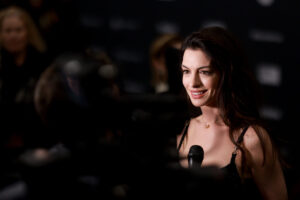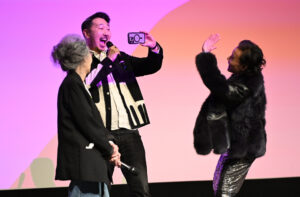PARK CITY, UTAH – JANUARY 21: (L-R) Emilia Jones and Nicholas Braun and attend 2023 Sundance Film Festival “Cat Person” Premiere at Eccles Center Theatre on January 21, 2023 in Park City, Utah. (Photo by Amy Sussman/Getty Images)
By Bailey Pennick
It was a terrible kiss, shockingly bad; Margot had trouble believing that a grown man could possibly be so bad at kissing. — Cat Person, 2017
“The first thing I think of is the horrible kiss,” Nicholas Braun laughs. The sold-out Eccles Theatre crowd for Cat Person’s world premiere erupts into groans and laughter with the actor. “That was step one to figure out, and [then our acting chemistry and trust with each other] all builds off that moment.” In Susanna Fogel’s latest film, based on Kristen Roupenian’s viral short story in The New Yorker, “horrible” things escalate pretty quickly past one bad first kiss, but it is true that the image of this uncoordinated mouth to mouth is hard to shake. Emilia Jones is in complete agreement with her colleague. “From that moment on, Nick and I were very close,” she recalls. “We laughed in each other’s mouths during those takes!”
This level of communication and trust between the cast and crew of Cat Person is refreshing, considering the film they produced examines the darker side of what Fogel calls “maybe just a catastrophic mess of miscommunication” within the (always chaotic) world of dating.
Chock-full of moments of cringey memories and nervous laughs of personal experience recognition, the film inventively blends the interior fears and fantasies of Margot (an excellent Jones) with the external experience of an awkward, budding relationship with Robert (Braun, deftly playing against type). Beyond the physical power dynamic imbalance between a small college student and a larger older man, Cat Person keeps a tense and uncomfortable tone throughout its pacing and the conversations between the couple — especially when it comes to their favorite things like movies.
“Both Robert and Margot are trying to build personas for themselves and project about each other from the movies they’ve seen and the pop culture they’ve engaged with,” Fogel explains. “And [this includes the type of] men and women they’ve tried to be. So we wanted to be specific about the types of masculinity and femininity they were trying to [embody].” From Margot’s fantasies of Robert in a cream fisherman’s sweater gushing to a therapist about her to Robert’s obsession with Harrison Ford, Cat Person expands the scope of this short story to go beyond the pair and open the conversation about how society has, in some ways, trained us all to date ideas instead of individuals, and the utter lack of a road map when that becomes unwanted or dangerous.
“Kristen’s story was so specific about the interior fears and projections that women have,” says Fogel of the continuous confusion of being a woman dating in this world. “And what is sort of built into trying to connect with a man, but you’re physically smaller than a man. But you’re trying to fall in love, but then you’re told, culturally, to fear them because they can attack you at any moment.” Heads nod in emphatic agreement throughout the cast, crew, and room. “There are a lot of competing narratives that we’re fed, especially now, and we talked about manifesting these internal fears in an externalized sense of danger — even if it’s just that adrenaline, cortisol flash of danger that women just have when they’re in a situation with a person they don’t know.”
And while Roupenian’s original piece, which resonated with so many women, ends with a simple example of toxic masculinity via passive aggressive texting, Fogel wanted to extend the experience of being Margot for filmgoers: “Trying to play out the worst-case scenario to the fullest extent was the way to immerse people into Margot’s internal state of mind.” Even as the feelings of being trapped in an uncomfortable situation give way to actually being trapped in the film’s third act, there’s still this nagging feeling that this entire nightmare is a gigantic gray area of misunderstanding.
“People were really divided about the [original] story and said that one of these people needs to be the villain,” says Fogel. “And what we’re trying to say is that neither of these people is a villain.” And as for the larger message? “We just want [this film] to continue the conversations [from the short story], but we want people to keep talking about the gray areas of dating and intimacy. We’ve seen a lot of the female revenge narratives, but this [ambiguity] is the next step in those conversations.”










